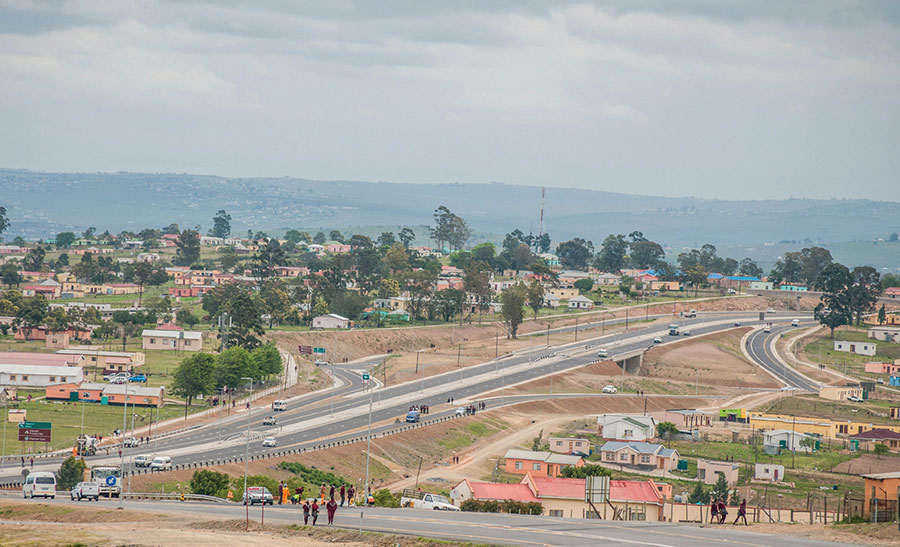
TRAINING and skills development initiatives
advanced members of the local communities who
worked on the R61 Mthatha to Nqgeleni project in
the Eastern Cape.
The project, which forms part of a bigger master
plan for tourism and other long-term mega projects
in the Eastern Cape, created work opportunities for
60 small, medium and micro enterprises (SMMEs)
of which 48 were black-owned entities. There were
628 job opportunities created.
Sixteen Walter Sisulu University students from
the community also gained on-site experiential
training to obtain their diploma qualification.

(SMMEs)
“Local SMMEs were mentored in the
construction of relocation houses to National
Home Builders Registration Council (NHBRC)
standards and participated in several courses that
include construction tendering, basic computer
literacy skills, site administration and monitoring.
The workers have been provided with, among
others, road safety and environmental awareness
training,” said Thabiso Ngozwana, SANRAL
Project Manager.
The R550m project commenced on 16 September
2013 and was finalised on 8 September 2017.
“I attended the entrepreneurship course and it
was an eye-opener for me. The course has helped
me a lot. I am able to deal with payments and
record the work that we worked on,” said Joshua
Mbangeleli owner of Ayabulela Genera Trading.
Mbangeleli employed 14 people to work on
the project. Their tasks included concrete works –
working on storm water pipes, building walkways,
stone pitching, drop-inlets and outlets.
“The road is much safer to use now. Community
members can use underpasses and walkways
instead of crossing over the R61,” Mbangeleli said.
The project included the construction of a new
7.3km dual carriageway between Mthatha and the
turn-off to Ngqeleni. A new eastbound carriageway
was constructed, and significant improvements
were made to the westbound carriageway.
“One of the successes is that the project has
already injected a range of benefits to members
living in villages from Mthatha to Ngqeleni,”
Ngozwana said.
SANRAL delivered 31 new replacement houses
to residents whose dwellings fell under the construction
footprint, and in the process eradicated
poorly constructed structure homes.
As part of this road safety initiative, unsafe
intersections were closed, a new interchange at
Ngqeleni turn-off was built and formalised, and
channelled intersections were constructed.
Six new bridges and two agricultural underpass
culverts were also constructed to help reduce the
number of road incidents caused by stray animals
on this national road.
The project also links with other programmes
including the conversion of Sprigg Street and
Madeira Street in Mthatha’s Central Business District
(CBD) into one-way system to help improve traffic
flow.

TRAINING PLAYS AN IMPORTANT ROLE IN SHAPING SMMES
There is more to running a business than
just building a road, according to Marlize
Nel-Verwey SANRAL Southern Region
project manager.
“It is important for SMMEs to know
how a business fits together. Through our
training programmes we aim to expose
the SMMEs to as much as possible in the
industry.”
Although 23% of the national road
network is in the Eastern Cape, 35% of
SANRAL’s SMME training over the past two
financial years took place in this pr ovince.
In this current financial year SANRAL has
21 Community Development (CD) projects
under construction of which 15 (71%) are
in the Eastern Cape.
“SANRAL runs continuous training for
SMMEs in the Southern Region before and
during a project,” Nel-Verwey said.
SANRAL has been running training
programmes for SMMEs since its inception
in 1998. These have become more focused
since 2006 and have escalated since 2010.
Diagrams depict SMME training figures in each region during two financial years:

Female Youth <35 (28.05%)
Male (23.36%)
Male Youth <35 (34.50%)

Female Youth <35 (20.73%)
Male (20.73%)
Male Youth <35 (41.46%)

Female Youth <35 (27.27%)
Male (22.18%)
Male Youth <35 (42.18%)

Female Youth <35 (29.49%)
Male (21.37%)
Male Youth< 35 (40.60%)

Female Youth <35 (43.30%)
Male (10.01%)
Male Youth <35 (26.66%)

Female Youth <35 (21.81%)
Male (26.48%)
Male Youth <35 (47.98%)

Female Youth <35 (32.50%)
Male (26.67%)
Male Youth< 35 (31.67%)

Female Youth <35 (10.29%)
Male (28.81%)
Male Youth< 35 (53.49%)